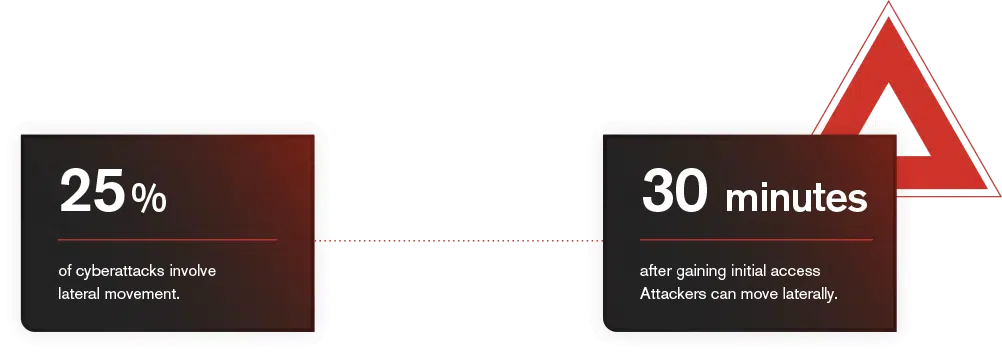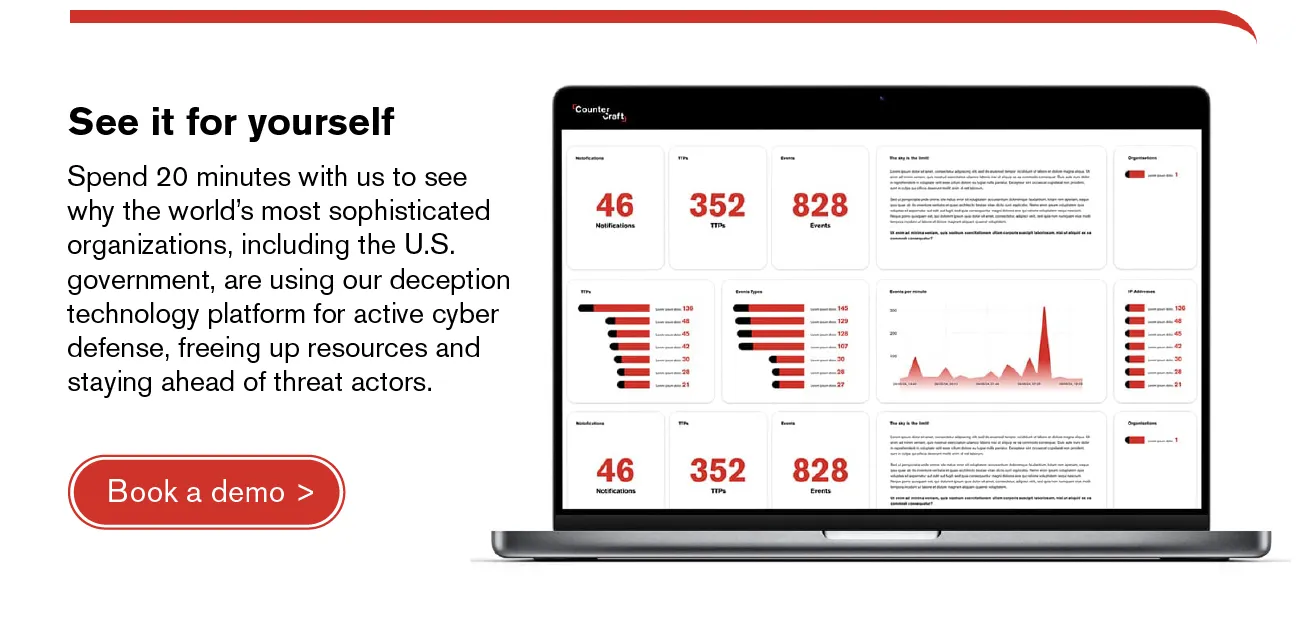Lateral movement is one of the most difficult cybersecurity issues to solve. This technique, where attackers move within a network to access sensitive data or systems, has been a hallmark of many high-profile breaches. As cyber threats grow more sophisticated, the question arises: What is the best defense against lateral movement?
In this blog, we will delve into the intricacies of lateral movement, exploring its impact and historical context. We will then examine deception technology, a cutting-edge approach designed to mislead attackers and thwart their efforts. By deploying decoys and traps, deception technology is able to detect and prevent lateral movement better than any other single technology, and it does so before significant damage occurs.
What is lateral movement?
Lateral movement allows attackers to navigate through a network, often using legitimate credentials, making it difficult to detect. This technique has been a key component in numerous data breaches, including the infamous Target breach in 2013 and the more recent SolarWinds attack. Understanding the history and impact of lateral movement is crucial for developing effective defense strategies.
What is deception technology?
Deception technology creates a maze of decoys and traps within a network, designed to lure attackers away from valuable assets. By mimicking real systems and data, these decoys can detect and analyze malicious activity in real-time, providing early warnings and valuable insights. This proactive approach not only helps in identifying threats but also reduces the dwell time of attackers within the network.
Case studies: Big data breaches involving lateral movement
Several high-profile breaches have highlighted the dangers of lateral movement:
Here are some additional examples of breaches that involved lateral movement:
- Target (2013): Attackers gained access through a third-party vendor and moved laterally to steal credit card information.
- SolarWinds (2020): Attackers infiltrated the network management software, moving laterally to compromise multiple government and private sector systems.
- Uber Breach (2022): Attackers gained access to Uber’s internal systems and moved laterally to access sensitive data and administrative tools.
- Colonial Pipeline Ransomware Attack (2021): Attackers used compromised credentials to move laterally within the network, eventually deploying ransomware that disrupted fuel supply across the Eastern United States.
- NotPetya Attack (2017): This ransomware spread laterally across networks using the EternalBlue exploit, causing widespread disruption to businesses globally
- Sony Pictures Hack (2014): Attackers moved laterally within Sony’s network, stealing vast amounts of data and deploying destructive malware.
These examples highlight the significant impact lateral movement can have on organizations, emphasizing the need for robust cybersecurity measures to detect and prevent such activities.
By examining these cases, we can better understand how deception technology could have mitigated the damage and potentially prevented the breaches.
Understanding lateral movement
Lateral movement in cybersecurity refers to the techniques attackers use to move through a network after gaining initial access. This allows them to explore the network, escalate privileges, and reach their ultimate targets, such as sensitive data or critical systems.
How It Works
- Initial Access: Attackers gain entry through methods like phishing, malware, or exploiting vulnerabilities.
- Reconnaissance: They gather information about the network, identifying valuable assets and potential paths.
- Credential Theft: Using techniques like keylogging or exploiting weak passwords, attackers steal credentials to access other parts of the network.
- Privilege Escalation: They gain higher-level access, often aiming for administrator privileges.
- Lateral Movement: Attackers move from one system to another, often using legitimate tools to avoid detection.
Lateral movement is a growing trend in cyberattacks. A 2023 report observed lateral movement in about 25% of all cyberattacks, highlighting its prevalence. The increasing complexity of networks and the sophistication of attackers contribute to this trend.
Organizations of all sizes and sectors can be affected by lateral movement. High-value targets include:
- Financial institutions
- Healthcare providers
- Government agencies
- Large enterprises
Understanding deception technology: A powerful tool
Deception technology has emerged as a powerful tool to combat sophisticated cyber attacks that utilize lateral movement. Deception technology has been gaining traction among CISOs for over a decade, with significant advancements and adoption occurring in the last five to ten years.
What is Deception Technology?
Deception technology involves creating decoys and traps within a network to mislead attackers, diverting them away from valuable assets and towards fake resources. This strategy not only protects critical data but also provides valuable insights into attacker behavior, helping organizations strengthen their defenses. These decoys can be anything from fake servers and applications to bogus data and credentials. When attackers interact with these decoys, they reveal their presence and tactics, allowing security teams to respond swiftly and effectively.
Different Kinds of Deception Technology
- Honeypots: Decoy systems designed to attract attackers. They appear as vulnerable systems, enticing attackers to engage with them.
- Honeytokens: Pieces of data or credentials that, when used, alert the security team to a breach.
- Decoy Networks: Entire network segments that mimic the real network environment, luring attackers into a controlled space.
- Decoy Files: Fake files that appear valuable but are designed to trigger alerts when accessed.
Effectiveness of Deception Technology
- Early Detection: Deception technology is highly effective in detecting threats early. By luring attackers to decoys, it can identify breaches before they reach critical assets.
- Internal Threats: It is also useful for uncovering internal threats, such as employees accessing unauthorized data.
- Psychological Impact: The uncertainty it creates for attackers—whether they are interacting with real assets or decoys—can deter and disrupt their activities.
- Complementary Tool: Deception technology works well alongside traditional security measures, enhancing overall security posture by providing additional layers of detection and response.
- Cost-Effective: It can be a cost-effective solution, reducing the need for extensive manual monitoring and allowing security teams to focus on genuine threats.
When integrated properly with other security strategies, deception technology offers a powerful means to outsmart cyber attackers and protect valuable data.
How deception technology detects and stops lateral movement
Attackers in your network are impossible to detect with traditional security toolsets, such as host-based security controls (EDR) or network monitoring solutions (IDS), leaving them free to roam your network searching for sensitive data and other high-value assets. Even if the point of entry is discovered, threat actors already in the network can easily avoid detection and retain access.
Cyber deception is one of the only ways to identify lateral movement of attackers in real time.
Deception technology is particularly effective at detecting and stopping lateral movement. By placing decoys strategically within the network, security teams can monitor for unauthorized access and unusual activity. When an attacker interacts with a decoy, it triggers an alert, allowing the security team to take immediate action. This not only stops the attacker in their tracks but also provides valuable information about their methods and objectives.
With absolutely no impact on production systems, CounterCraft rapidly detects attackers moving laterally by placing lures and breadcrumbs across networks which, when tripped, allow SOC managers to watch every move.
Comparing Deception Technology with Traditional Security Measures
Deception technology offers unique advantages compared to traditional security measures, making it a valuable addition to a comprehensive cybersecurity strategy. Here’s a comparison:
Traditional Security Measures
- Firewalls and Intrusion Detection Systems (IDS):
- Function: Monitor and control incoming and outgoing network traffic based on predetermined security rules.
- Strengths: Effective at blocking known threats and monitoring network traffic.
- Limitations: Can be bypassed by sophisticated attacks, especially those using zero-day vulnerabilities.
- Antivirus and Anti-malware Solutions:
- Function: Detects and removes malicious software.
- Strengths: Good at identifying known malware signatures.
- Limitations: Less effective against new, unknown threats and can generate false positives.
- Authentication and Access Controls:
- Function: Ensure that only authorized users can access certain resources.
- Strengths: Essential for protecting sensitive data.
- Limitations: Can be compromised through phishing or social engineering attacks.
Deception Technology
- Proactive Detection:
- Function: Deploys decoys and traps to lure attackers.
- Strengths: Detects threats early by engaging attackers before they reach critical assets.
- Threat Intelligence Gathering
- Function: Identifies and analyzes the playbook of threat actors
- Strengths: Enhances situational awareness by providing insights into attacker methodologies and tactics, allowing for informed responses.
- Low False Positives:
- Function: Differentiates between legitimate user activities and malicious interactions.
- Strengths: Reduces alert fatigue by minimizing false positives.
- Psychological Impact:
- Function: Creates uncertainty for attackers about the authenticity of their targets.
- Strengths: Can deter and disrupt attacker activities by making it harder for them to distinguish real assets from decoys.
Usage and effectiveness in businesses globally
Deception technology is increasingly being adopted by businesses worldwide. According to a report by Gartner, the use of deception technology has grown significantly in recent years, with many organizations integrating it into their cybersecurity strategies. Its effectiveness lies in its ability to detect threats early, reduce false positives, and provide actionable intelligence. By diverting attackers to decoys, businesses can minimize the impact of breaches and gain insights into attacker methods, thereby enhancing their overall security posture.
CounterCraft is a leading provider of deception-powered threat intelligence. CounterCraft specializes in creating sophisticated deception environments to detect and prevent cyberattacks. Our flagship product, The Platform, uses advanced deception technology to lure attackers away from critical assets and gather actionable threat intelligence.
CounterCraft’s platform creates a digital twin of an organization’s environment, complete with decoys and traps that mimic real systems and data. When attackers interact with these decoys, the platform collects detailed information about their methods and objectives. This intelligence is then used to strengthen the organization’s defenses and prevent future attacks.
The Platform is designed to be highly configurable, allowing organizations to tailor it to their unique attack surface. It provides real-time alerts and detailed reports, giving security teams the information they need to respond quickly.
Conclusion
Deception technology represents a significant advancement in the field of cybersecurity, offering a proactive and innovative approach to detecting and mitigating threats. By creating a network of decoys and traps, organizations can effectively mislead attackers, gather valuable intelligence, and respond to threats before they cause significant damage. While traditional security measures remain essential, the integration of deception technology provides an additional layer of defense that enhances the overall security posture.
As cyber threats continue to evolve, the need for sophisticated and adaptive security solutions becomes increasingly critical. Deception technology not only addresses the challenge of lateral movement but also offers a comprehensive strategy for protecting sensitive data and critical systems. By staying ahead of attackers and leveraging the power of deception, organizations can safeguard their digital assets and maintain resilience in the face of ever-changing cyber threats.
For more information about how deception technology can benefit your organization, consider exploring solutions like CounterCraft, which specialize in creating advanced deception environments tailored to your unique security needs.
Lateral movement allows attackers to navigate through a network, often using legitimate credentials, making it difficult to detect. This technique has been a key component in numerous data breaches, including the infamous Target breach in 2013 and the more recent SolarWinds attack.


